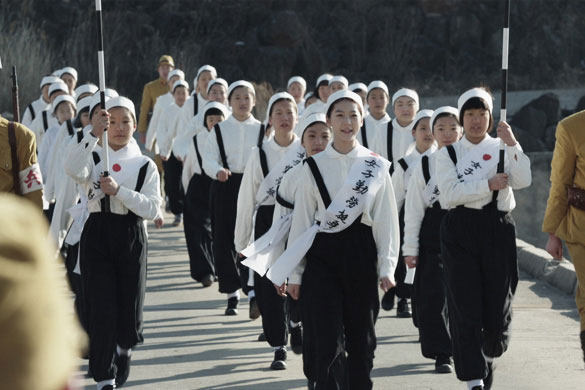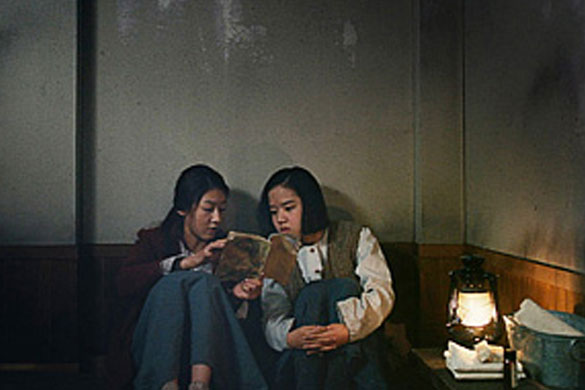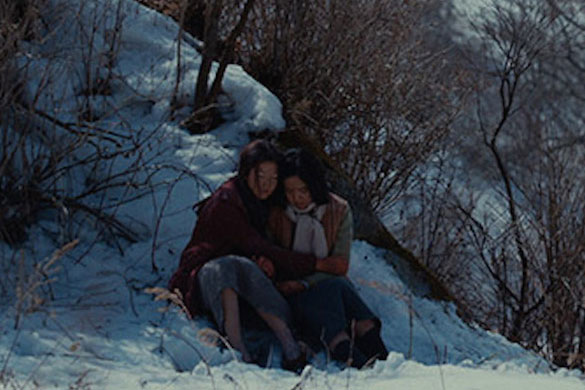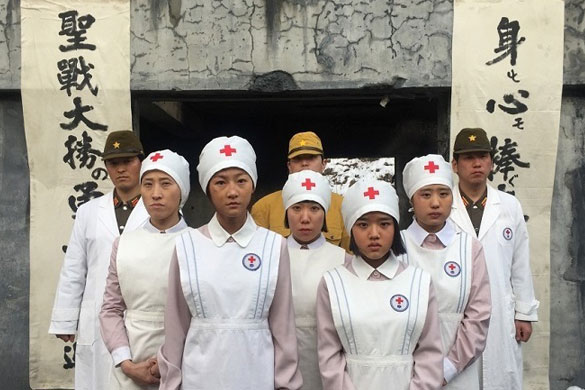
 |
||||
Jong-boon (Kim Hyang-gi) and Young-ae (Kim Sae-ron) are young girls living in a rural village in colonial Korea, under Japanese rule. While Young-ae comes from a fairly well-to-do family allowing her to have decent clothes, attend school and never struggle for food, Jong-boon’s impoverished upbringing gives her no such trappings or luxuries and though she would truly love to be part of Young-ae’s world their difference in circumstances means that is unlikely to ever be.
Review: Snowy Road opens with a stark yet visually arresting winter scene showing Jung-boon running through a landscape deep with snow, desperately and repeatedly calling out to Young-ae who, clearly battered and bruised, walks labouredly and painfully – almost to the point of staggering – across a frozen area of water which soon begins to crack... In the early stages of the historical timeline (as already briefly mentioned) we are shown the vast differences in lives of – and indeed the opportunities available to (or not) – rich vs. poor, higher vs. lower class: Young-ae coming from a well-to-do family is allowed to attend school, get an education and even consider a future career (she, for a time at least, believes that she will be travelling to Japan to study to become a teacher). Conversely, Jong-boon as a poor child is simply expected to help her mother in her daily work, put “silly” ideas of attending school, getting an education and even learning to read and write out of her head and concentrate on finding a husband as soon as possible. In fact, the vast chasm between the social standing of the two is underlined yet further by Young-ae’s repeated blunt statement that Jong-boon will never be allowed to marry Young-ae's brother with whom Jong-boon is clearly enamoured – a statement that will resonate throughout the film and indeed take on a far greater importance in the narrative’s latter stages. Indeed, there is even reference to the (wholly unfair) social stigma associated with what these women have been forced to undertake, through no fault of their own, and the adverse effect it would have on their lives and position in society should they ever manage to escape and return to Korea, with Young-ae resolutely stating that she will without hesitation lie about where's she's been and what she's had to do.
That very stigma still looms large in the mind of the present day elderly character. The social commentary in this timeline relates not only to this and by extension to the character’s choices in her interactions with others (namely, authority figures) but also shows in her efforts to help a troubled young woman who has largely been pushed to the edge of society and whose life (or, more accurately, existence) largely cascades from one disaster to another. Not only that, but the young tearaway's thoughts and opinions on finding out what happened to Jong-boon and Young-ae speak as much of changes that have taken place in Korean society over the years as any other reference. As if that wasn't enough, the decision to have Young-ae (as a young girl) repeatedly appear to and converse with the old lady in the present day not only draws a perfect, definitive line between past and present but also says a great deal about how the ongoing, never ending psychological scars from her past trauma continue to affect and influence her every current moment.
There have of course been a fair few films over the years focused on the subject of 'comfort women', with some such as Spirits' Homecoming having a narrative bearing more than a passing resemblance to that of Snowy Road (a story of two young women forced into sexual slavery by the Japanese; a narrative split between past and present; one of the women shown in the present day as an elderly lady with the whereabouts of the other of the comfort women characters at least initially unclear). However, in almost all instances regardless of similarities each such example has enough originality in its ultimate focus to be as worthy as any other and with the subject of 'comfort women' being so important - and indeed with the vital need for continued awareness of the historical atrocities committed by the Japanese against young, innocent Korean women to be repeatedly raised - as far as I'm concerned too much is never enough. As a final point, the calibre of acting in Snowy Road is exemplary across the board, whether you consider Kim Sae-ron’s performance as Young-ae; Kim Hyang-gi's as Jong-boon (two young, incredibly talented actresses whose careers are massively on the rise); or indeed look at Jang Young-nam in the role of Jong-boon’s mother (a well respected actress for many years); or any of the other supporting cast parts. That statement being, frankly, an undeniable fact hopefully means that when I say that, for me, Kim Hyang-gi's performance stood out as the most perfectly nuanced and utterly natural you'll understand just how phenomenal she is in the role of young girl Jong-boon.
SNOWY ROAD (눈길 / 2017)
|
||||
All images © CGV Arthouse Review © Paul Quinn |
||||



